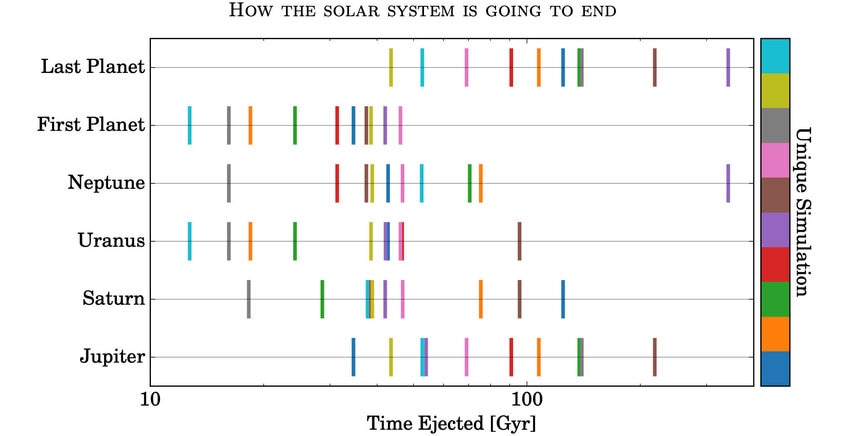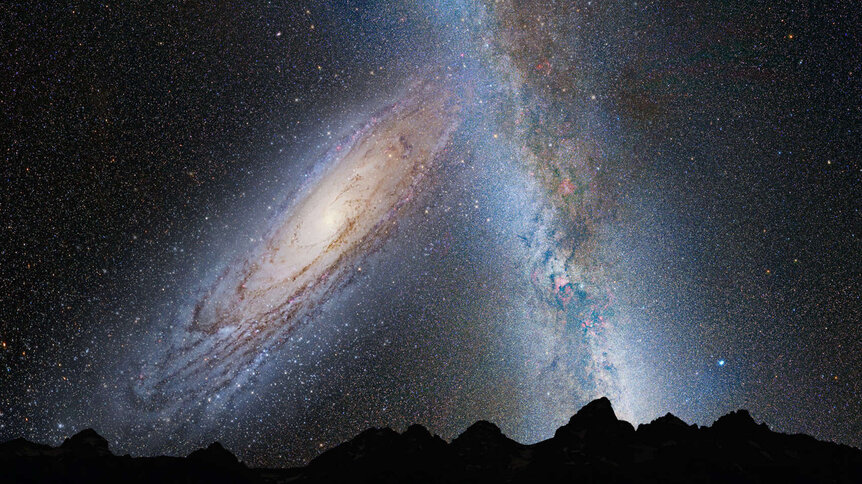Create a free profile to get unlimited access to exclusive videos, sweepstakes, and more!
How our galaxy will kill our solar system in a trillion years, planet by planet

Here's a fun question: How will the solar system die?
OK, so maybe it's not so fun. But the science of it is at least interesting.
Most of the time when you read articles about this topic, the answer you get is that the Sun will use up its nuclear fuel, turn into a red giant, engulf Mercury, Venus, and Earth, blow off its outer layers, and then turn into a white dwarf, cooling off for eternity until it turns black and freezes to nearly absolute zero.
Mind you, this is all true, but that's not really what happens to the solar system, just the Sun and first three planets (one of which we have a vested interest in). But there's other stuff out there too, including Mars and four giant planets. They count too. Heck, Jupiter by itself has more mass than everything else in the solar system (except the Sun, duh) combined, so its fate is very important.
What happens to all them?
A paper recently published looks into exactly that. In general, and in the short term, the motions of the planets around the Sun are predictable. They follow equations first laid out by Isaac Newton in the 17th century, and we still use those equations in much the same way today.
However, in the long term that won't work. If you have more than two bodies orbiting each other, the system generally becomes chaotic after a sufficiently long time. I don't mean like stuff just flying everywhere; this is in the mathematical sense of chaos theory; that is, it's not possible to precisely predict where the planets will be at some point in the distant future because you can't precisely measure their positions and motions now. Any random error, no matter how small, propagates through the equations, growing larger over time, and eventually changes the solar system configuration in unpredictable ways.
To avoid that, you can compensate somewhat by including the uncertainties in your math and then running the equations lots of times, changing those values a little bit each time. The result is a bunch of different configurations after some time, but you can then look at them statistically. Like, in how many simulations did Jupiter and Saturn interact such that Saturn was tossed out of the solar system? You can't know which sim is right, but you can get a sense of what will happen this way.
In the new paper they went even farther. For one thing they included the Sun losing mass as it grows into a red giant. That's important, because as it does so its gravity gets weaker, and the orbits of the planets expand — they found that the planets Mars through Neptune have their orbits get bigger by a factor of about 1.85 as the Sun loses about half its mass in the next 7 billion years.
More than that, they also included the chances of stars in the galaxy getting close enough to the Sun to have an affect. Stars are small and very far apart — the nearest star to the Sun is over 40 trillion kilometers away — so encounters like this are rare.
But not nonexistent. And if you run a simulation far enough into the future, a star sideswiping the solar system becomes inevitable. So the scientists ran their simulations in two parts. The first was up to the Sun losing its mass, and the second was the long period after. They included semi-random stellar encounters, using the actual galactic environment (number of stars per cubic light year and their motions) to simulate that.
They found that in Phase 1 (before the Sun swells up), the planets are too close to the Sun for that to have much of an effect. Stars would have to pass much more closely even to strip away Neptune, and an encounter like that happens on the trillion year timescale. Extremely unlikely.
But once the Sun's a white dwarf and the planets are farther out, the odds go way up. The Sun's gravity is weaker, planets are more distant, and a chance stellar encounter has an easier time of stripping planets away, flinging them out into interstellar space.
They ran ten full simulations in this configuration. That's not many (usually in situations like this hundreds or even thousands are run) but they got such similar results each time they felt confident in their conclusions.
Basically, they found that a star is likely to pass within about 75 billion kilometers every 10 billion years or so. That's close enough to have some effect, and more encounters add up. In some sims, the outer planets were destabilized after roughly 45 billion years.
In all sims, Jupiter, Saturn, Uranus, and Neptune are ejected after at most a trillion years. Not surprisingly, Jupiter is generally the last survivor; it's the closest in, the most massive, and the hardest to kick out.
On average, the first planet is lost after 30 billion years, and the last after about 100 billion. Also, once the first planet is ejected, the system is destabilized enough that the next two follow within 5 billion years. The last planets tend to linger for another 50 billion, because there are no other planets in the system left to interact with and poke it gravitationally.
I'll note one big thing they left out of their simulations: Mars. They note that it may be the actual last planet to survive, since it's closest to the Sun and needs a really close stellar encounter to fling it away. So if you're looking for a very long-term real estate investment, the fourth rock from the Sun — once it becomes the first and only rock — is the way to go.
In the paper, they note that they don't include stellar encounters with binary stars, which are more efficient at poking at the solar system, so the results they find are likely upper limits to how long the system will last.
Also, the Milky Way will collide with the Andromeda Galaxy in 4.6 billion years, while the Sun is still a relatively normal star, and they didn't account for that either. Encounters will likely happen more often when the number of stars in the resulting merged galaxy has twice as many as we do now. Also, the collision will stir things up a lot, so this may all be moot anyway. The Sun might drop into the nucleus of the galaxy where stars are plentiful and encounters common, or be flung out into the suburbs where encounters are rare. And this is all long before the average stellar encounter affects their sims.
So clearly there's more work to be done here. But this is an excellent step to figuring it all out.
I sometimes wonder, why am I so fascinated by this topic? I mean, I literally wrote a whole book on this. It's more than just the morbid fascination with something like a horror movie, I think.
We see the solar system as immutable, but that's over a human lifetime. Over long periods it changes, a lot, and that's a shakeup of our complacency.
But more than that, there's a strange attraction to the idea of deep time, not just millions or even billions but trillions of years, or even epochs that make those numbers seem like a single tick of the clock. It's a window into something most of us never really considered before. What if we let time run on really long? What happens then?
Well, stars run out. Planets get flung into space. Galaxies collide. Quite a bit happens, actually.
The Universe is almost 14 billion years old, and we think that's a long time. But really, it's just getting started.































